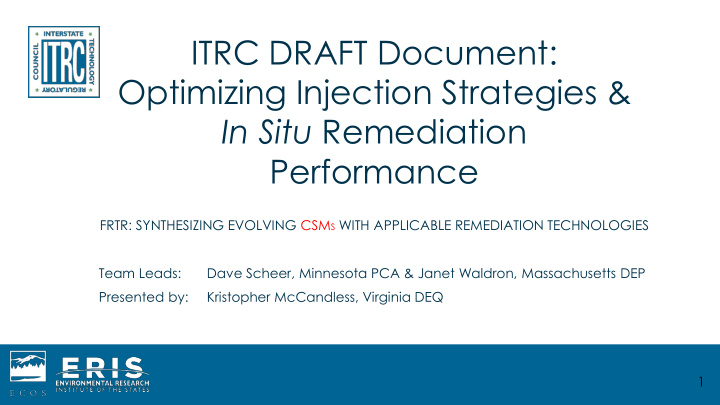



ITRC DRAFT Document: Optimizing Injection Strategies & In Situ Remediation Performance FRTR: SYNTHESIZING EVOLVING CSM S WITH APPLICABLE REMEDIATION TECHNOLOGIES Team Leads: Dave Scheer, Minnesota PCA & Janet Waldron, Massachusetts DEP Presented by: Kristopher McCandless, Virginia DEQ 1
What is ITRC? ITRC is a state-led coalition working to advance the use of innovative environmental technologies and approaches to translate good science into better decision-making. 2
As of March 7, 2019 Our Unique Network State/City/Local Government 10% Federal Government Private Sector 37% 907 Members Academia 44% Stakeholders 2% International Organizations 2% 5% 3 3
Federal Government Participants 4
Benefits to DOD and DOE Facilitate interactions between federal managers and state regulators Increase consistency of regulatory requirements for similar environmental problems in different states Provide harmonized approaches to using innovative technology across the nation Reduce review and approval times for those innovative approaches 5
ITRC Accomplishments Ed Educates state regulators on the use of innovative technologies Prom omot otes the use of innovative technologies Unites es state approaches to complex topics Insp spires collaboration over adversarial relationships 6
How Can YOU Benefit from ITRC? Take ITRC Use ITRC Training Documents Courses Join ITRC Teams 7
2020 Teams Use of Soil Background Concentrations in Risk Assessment (NEW) Per- and Polyfluoroalkyl Substances (PFAS) Update & Training 1,4-Dioxane (Continuing until Dec. 2020) Harmful Cyanobacterial Blooms (Continuing until Dec. 2020) Incremental Sampling Methodology Update (Continuing until Dec. 2020) Vapor Intrusion Mitigation Training (Continuing until Dec. 2020) Advanced Site Characterization Tools (ASCT) (Due in Early 2020) Optimizing Injection Strategies & In Situ Remediation Performance (Due in April 2020) 8
Optimizing Injection Strategies and In Situ Remediation Performance DRAFT INTERNET BASED DOCUMENT & TRAINING (GOING PUBLIC IN APRIL 2020) Team Leads: Dave Scheer, Minnesota PCA Janet Waldron, Massachusetts DEP 9
What is Optimization? Optimization is the effort (at any clean-up phase) to identify and implement actions that improve effectiveness and cost- efficiency of that phase. 10 This is the EPA definition cited in ITRC’s 2016 Geospatial Analysis Optimization document.
Foundation of this Document 2011 Integrated DNAPL Site Strategy (IDSS) 2015’s IDSS Site Characterization and Tool Selection Document Optimization addressed in other contexts Remediation Process Optimization (2004) (ITRC-RPO-1, 2004) Performance-Based Environmental Management (ITRC RPO-2, 2007) Geospatial Analysis for Optimization (2016) (GRO-1, 2016) 11
Purpose of this Document High Resolution Site Characterization Tools: Remedial Design Characterization Downhole geophysics, MiHPT/LIF/OIP, LIDAR, ER, tracer test, GPR, Packer testing Amendment Selection Table Delivery Factsheets Design Wheel Bench or Pilot Test Performance Monitoring OPTIMIZATION TOOL BOX 12
Structure of this In Situ Optimization Document Remedial Design Characterization (Ch 2) Amendment, Delivery, Dose Design (Ch 3) Implementation & Feedback (Monitoring) Optimization (Ch 4) Regulatory Perspectives (Ch 5) Community & Tribal Stakeholder Considerations (Ch 6) Hot links * Tables * Mouse-over Definitions * Factsheets * References * Case Studies 13
Who is this Document written for? The remediation manager who has had a failure of some type: Has pushed or moved the plume where they didn’t want it go Amendment is reacting with the geochemistry Delivery method not compatible with hydrogeology Have successfully cleaned up 50% of the mass and but stalled out for the rest The practitioner who is just about to start an in situ remediation project and wants to make sure they have chosen the correct remedy This document is NOT a 101 class for remediation! It assumes a basic CSM has been established and the hydrogeology is known 14
The Problem & Need for Optimization Out of all the proposals received by state regulators for remediation projects, about 40% of regulators deemed the first submittal as incomplete. Why? proposed remedy was not fully supported by the CSM CSM was inadequate inadequate amendment placement according to the CSM 15
Regulatory Linear Paradigm Main goal: clean up sites . Traditional approach to the remedial process was linear. 16
Interactive/Iterative Approach Evolution of environmental work has led to the realization that an iterative approach is required to efficiently clean up sites. ITERATIVE : To state repeatedly, repetitious, repetitive INTERACTIVE: Acting one upon (or with) the other 17
ITRC Documents Support Interactive/Iterative Approach 18
ITRC Documents Support Interactive/Iterative Approach Common goal: clean up sites The interactive/iterative approach will support the conceptual site models that change with new information In Situ remediation is particularly suited to the adaptive approach as unknowns are refined with bench tests, and pilot tests. 19
I have a failed remedy. Where do I start? Commonly Encountered Issues Associated with Remediation Design Characterization - Chapter 2 Lithology Contaminant Challenges, Lessons Learned, Discussion, Document Section, Links and/or Best Practices Reliance of MW data vs a full understanding of Continous profiling tools such as MiHPT, MiHPT-CPT, All contaminant mass distribution vs lithology vs LIF, LIF-CPT, LIF-CPT-MiHPT, MIP, MIP-CPT-MiHPT permeability (K) available through higher etc. or continous rock coring coupled with high density soil resolution site characterization (HRSC) or rock sampling and physical and chemical analyses. link technology to ITRC ISC-1 2015 (https://www.itrcweb.org/Guidance/ListDocuments?TopicI D=5&SubTopicID=49) Unrealistic expectations without a full Link to Ch 2 Knowledge of delivery and amendment understanding of site specific challenges - e.g. limitations in achieving contact and adequate residence time matrix back diffusion, which can lead to with mass sorbed to the soil matrix. contaminant concentration rebound after initial improvement in concentrations post-injection The amount of contaminant mass sorbed into Link to ITRC- FracRX-1 2017, Bedrock bedrock secondary porosity (https://www.itrcweb.org/Guidance/ListDocuments?TopicI D=58&SubTopicID=60) Soil Lack of understanding of contaminant mass Application of MiHPT, MiHPT-CPT coupled with high sorbed into finer grained soils. density soil sampling to determine extent and distribution of contaminant mass ITRC ISC-1 2015 (https://www.itrcweb.org/Guidance/ListDocuments?TopicI D=5&SubTopicID=49) Variability of K and calculated seepage velocity Higher resolution slug testing, tracer testing, or pilot testing Ground in contaminated intervals is needed to estimate with monitoring to determine amendment distribution in Water ROI (radius of influence) delivery approaches effective pore space and residence time within ROI. Table 1-1 (Appendix B) Issues commonly encountered during implementation of an in situ remedy 20
Recommend
More recommend